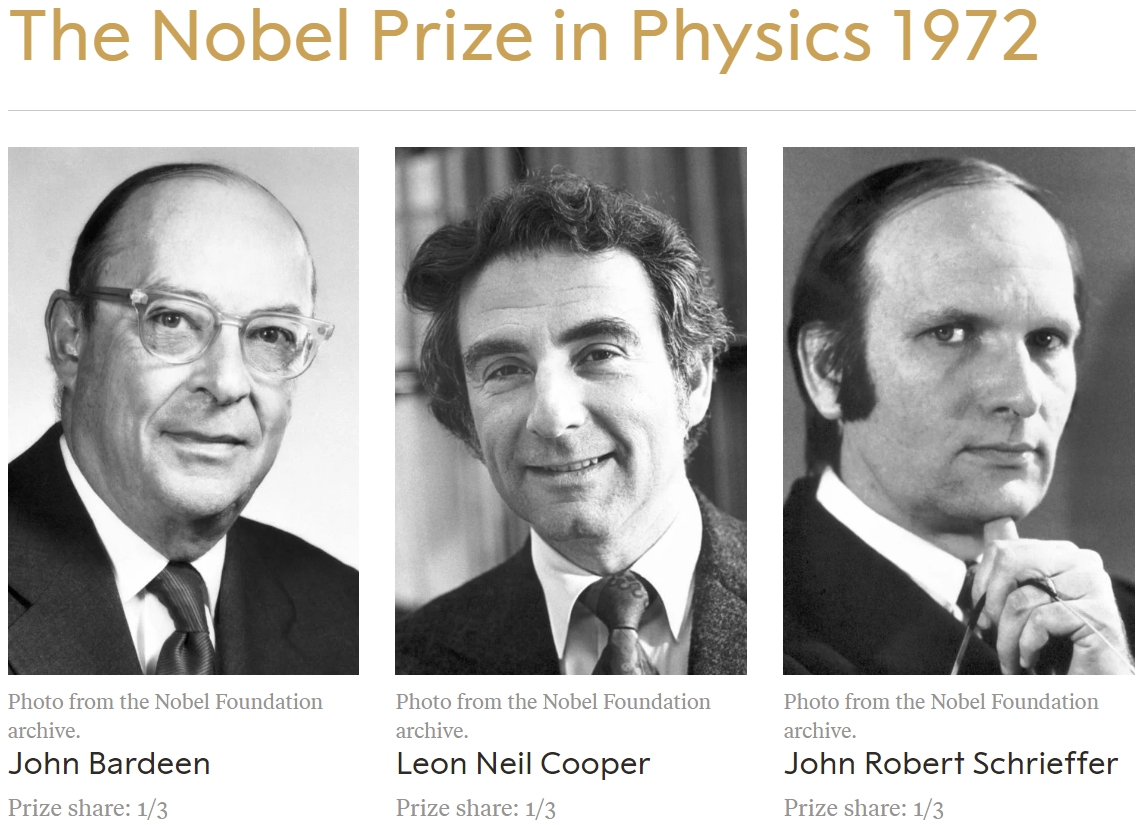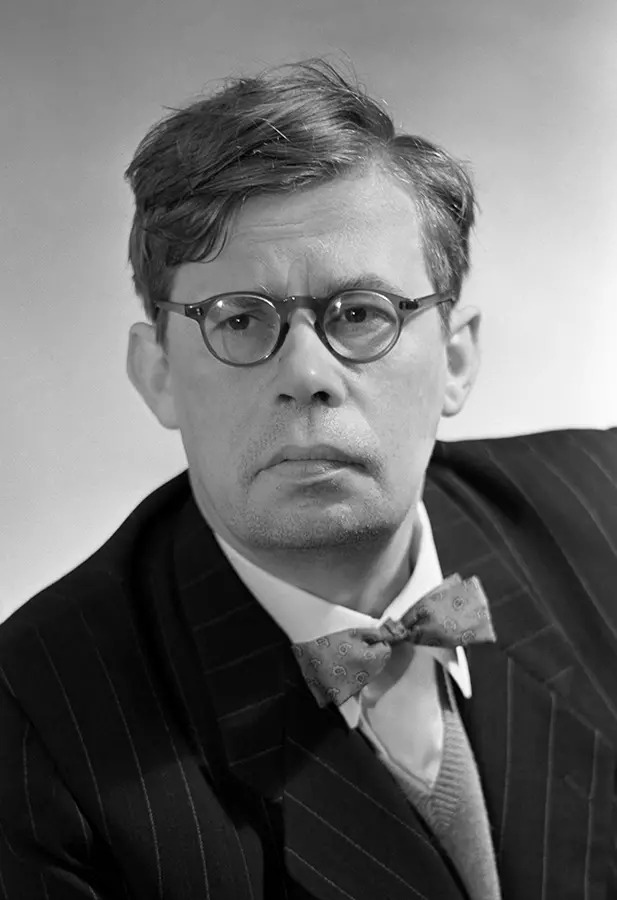博文
[打听,趣闻,轶事] 超导 BCS 理论建立的具体过程
||
[打听,趣闻,轶事] 超导 BCS 理论建立的具体过程
巴丁: John Bardeen, 1908-05-23 ~ 1991-01-30, 82
库珀: Leon Neil Cooper, 1930-02-28 ~ , 94+
施里弗: John Robert Schrieffer, 1931-05-31 ~ 2019-07-27, 88
超导: superconductivity
BCS 理论: BCS theory

图1 The Nobel Prize in Physics 1972
https://www.nobelprize.org/prizes/physics/1972/summary/
一、我以前听说的故事
据传:
巴丁第二次诺贝尔奖,
是被23岁小青年研究生“施里弗”强迫的。
(1)
23岁小青年研究生“施里弗”,
想破解超导。
担心自己不行,就去找巴丁。
腼腆的巴丁谦虚地说:
我这一把年纪,搞不了了。
怕这种【真正的原创】耽误施里弗。
(2)
恸哭的施里弗又去找别的教授。
结果遇到“伯乐”。
“伯乐”问施里弗:
你多大了?
施里弗:23。
“伯乐”笑了:
再过2年。你不才25岁吗?
意思是:
就算搞超导白费2年,你25岁时,一切都还来得及。
(3)
有了“伯乐”的鼓励,
施里弗又去磨巴丁。
腼腆的巴丁无奈,就说:
去找库珀吧。听听库珀怎说。
库珀这下子来精神了。
于是乎
BCS理论提出来了。
(4)
总之,
腼腆的巴丁,
“被”得到两次诺贝尔奖。
(5)
网传:
1956年,巴丁第一次去领诺贝尔奖时,
颁奖的瑞典国王古斯塔夫六世问他:“没有带孩子们来?”
腼腆的巴丁不善言辞,一时不知道怎么回答,就说“下次吧”。
1972年,巴丁再次获得诺贝尔物理奖。
王涛老师讲的故事:
https://blog.sciencenet.cn/blog-107667-1443016.html
嗯,你这个故事更加具有有趣。这个肯定不应该是这样的。那个时候研究超导是凝聚态物理的热门,但是场论的技术并不流行,巴丁是少有的意识到场论可能是研究超导很重要的工具。当时费曼,利用场论开始研究超导,但是没有找到关键的地方。巴丁意识到了一个很重要的事情,就是电子和声子之间的相互作用,也许,有可能是吸引的。这是一个非常重要的启发,于是巴丁就跟杨振宁先生打电话,问有没有精通场论的,杨振宁先生这边正好有个博士后,就是库伯,于是就把他推荐给巴丁了。各种巧合吧,当时正好施里弗正好赶上这一波。
2024-7-20 15:389 楼(回复 6 楼)
是的,这是一个美妙的故事。施里弗给出了超导的波函数,这似乎是在他坐车的时候想到的。巴丁给出了哈密顿量,库伯给出了物理图像,施里弗给出了用来变分的波函数形式。这是一个完美的合作的案例。由于给出了波函数获得诺贝尔奖的非常少见,另一个就是劳夫林给出了理解量子分数霍尔效应的波函数。
2024-7-20 17:5815 楼(回复 14 楼)
二、一些相关的权威资料
以下汉语来自【机器翻译】。个别之处进行了人工修改。
本节以下都是“直接引用”。感谢原作者和有关人员!
2.1 Science, 2019-09-20, John Robert Schrieffer (1931–2019)
https://www.science.org/doi/10.1126/science.aaz2849
He received a bachelor of science degree in physics from the Massachusetts Institute of Technology in 1953. There, under the guidance of John Slater, he became interested in solid-state physics. He did his graduate work with physicist John Bardeen at the University of Illinois Urbana–Champaign (UIUC). When he went to see Bardeen about a possible thesis problem, Bob later recounted, Bardeen pulled out a paper from his desk with a list of 10 possible projects. At the bottom of the list was “superconductivity.”
1953年,他获得了麻省理工学院物理学学士学位。在那里,在约翰·斯莱特的指导下,他对固态物理学产生了兴趣。他在伊利诺伊大学厄巴纳-香槟分校(UIUC)与物理学家John Bardeen一起完成了他的研究生工作。鲍勃后来回忆说,当他去找巴丁讨论一个可能的论文问题时,巴丁从桌子上拿出一张纸,列出了10个可能的项目。列表的底部是“超导性”
Superconductivity was first observed in 1911, and all the greatest theorists attempted to explain it in the decades after the invention of quantum mechanics. The solution required a leap of imagination. Bob achieved the mathematically simple but conceptually profound step when he wrote down an explicit wave function—one that violates the otherwise immutable principle of particle number conservation. This opened the door to a number of successful predictions of the BCS theory.
超导性于1911年首次被观测到,在量子力学发明后的几十年里,所有最伟大的理论家都试图解释它。解决方案需要想象力的飞跃。当Bob写下一个显式的波函数时,他实现了数学上简单但概念上深刻的一步——这个波函数违反了粒子数守恒的不变原理。这为BCS理论的许多成功预测打开了大门。
2.2 Nature, 2019-10-08, J. Robert Schrieffer (1931–2019)
https://www.nature.com/articles/d41586-019-03015-3
In early 1957, Schrieffer, then a 25-year-old graduate student, wrote down a quantum-mechanical wave function that accounted for the behaviour of electrons in superconductors. With his thesis adviser John Bardeen and postdoc colleague Leon Cooper, he published the now-famous BCS wave function and the full theory of superconductivity less than a year later — named BCS after the trio, who shared the Nobel prize (J. Bardeen, L. N. Cooper and J. R. Schrieffer Phys. Rev. 108, 1175; 1957).The work has had far-reaching consequences for both fundamental science and practical technology. Schrieffer continued to make foundational contributions to our understanding of electrons in solids.
1957年初,25岁的研究生Schrieffer写下了一个量子力学波函数,解释了超导体中电子的行为。不到一年后,他与论文导师John Bardeen和博士后同事Leon Cooper一起发表了现在著名的BCS波函数和完整的超导理论,以三人组的名字命名BCS,他们共同获得了诺贝尔奖(J.Bardeen,L.N.Cooper和J.R.Schrieffer Phys.Rev.1081175;1957)。这项工作对基础科学和实用技术都产生了深远的影响。Schrieffer继续为我们理解固体中的电子做出了基础性贡献。
Born in Oak Park, Illinois, in 1931, Schrieffer studied physics at the Massachusetts Institute of Technology in Cambridge as an undergraduate. It was at graduate school at the University of Illinois at Urbana-Champaign that he began working with Bardeen, who in 1956 had just won a share of the physics Nobel for the invention of the transistor.
Schrieffer于1931年出生于伊利诺伊州的橡树园,本科时在剑桥的麻省理工学院学习物理学。正是在伊利诺伊大学厄巴纳-香槟分校的研究生院,他开始与巴丁合作,巴丁于1956年因发明晶体管而获得诺贝尔物理学奖。
Bardeen suggested Schrieffer try his hand at understanding superconductivity. This was a risky proposition. After the initial success of quantum theory in describing ordinary conductors, insulators and semiconductors, there had been countless attempts to explain superconductors and all had failed. But the timing was right. Bardeen, with his then-postdoc David Pines, had studied the effect of phonons (quantized sound waves) on metals, showing that they mediated an attractive interaction between electrons. Cooper found that this attractive interaction could lead to the formation of bound pairs of electrons. However, Cooper’s theory described only the formation of a single electron pair. The question remained how to describe the many electrons pairing in the full electronic state of the metal, and why such pairing would lead to the properties of a superconductor.
Bardeen建议Schrieffer尝试理解超导性。这是一个有风险的提议。在量子理论在描述普通导体、绝缘体和半导体方面取得初步成功之后,人们无数次试图解释超导体,但都失败了。但时机是对的。Bardeen和他的博士后David Pines研究了声子(量子化声波)对金属的影响,表明它们介导了电子之间的吸引相互作用。库珀发现,这种有吸引力的相互作用可能导致束缚电子对的形成。然而,库珀的理论只描述了单个电子对的形成。问题仍然是如何描述金属全电子态下的多电子配对,以及为什么这种配对会导致超导体的性质。
Schrieffer’s intuitive leap came to him on the subway while attending an APS meeting in 1957. It struck him that a natural wave function for describing a state with electron pairing was one in which the number of electrons was not fixed, but had a certain quantum mechanical uncertainty. He wrote it down there and then. This key insight, radical at the time but now part of the standard toolkit of theoretical physics, cracked the problem wide open. With the wave function in hand, it quickly became possible to calculate many of the observed properties of superconductors, and to predict new properties, which were subsequently found.
1957年,Schrieffer在参加APS会议时,在地铁上突然灵机一动。他突然想到,描述电子配对状态的自然波函数是一种电子数量不固定,但具有一定量子力学不确定性的函数。他把它写在那里,然后。这一关键见解在当时是激进的,但现在是理论物理学标准工具包的一部分,它彻底解决了这个问题。有了波函数,很快就可以计算出超导体的许多观测特性,并预测随后发现的新特性。
2.3 尼科莱·勃格留波夫(Nikolay Bogolyubov)
https://www.kepuchina.cn/article/articleinfo?business_type=100&classify=0&ar_id=199144
在BCS理论提出的同时,尼科莱·勃格留波夫(Nikolay Bogolyubov)也独立的提出了超导电性的量子力学解释,他使用的勃格留波夫变换(英语:Bogoliubov transformation)(Bogoliubov transformation)为人常用。
是这位 Боголюбов Николай Николаевич 吗?

图2 Боголюбов Николай Николаевич, 1909-08-08 ~ 1992-02-13, 83
https://bigenc.ru/c/bogoliubov-nikolai-nikolaevich-c38609
Разработал (1946–1947) метод получения цепочек кинетических уравнений, носящих его имя. В 1946 г. построил микроскопическую теорию сверхтекучести на основе модели слабонеидеалного бозе-газа. Обобщив аппарат канонических преобразований, развитый им в теории сверхтекучести, создал (1956) микроскопическую теорию сверхпроводимости. Боголюбов заложил основы аксиоматической квантовой теории поля (1954–1955), впервые сформулировав принцип причинности в микромире.
1946年至1947年,他开发了一种方法来获得以他的名字命名的动力学方程链。1946年他在弱理想玻色气体模型的基础上建立了超流体微观理论。通过推广他在超流体理论中发展的规范变换器,他创造了超导显微镜理论(1956年)。勃格留波夫(Bogolyubov)是公理量子场论(1954-1955)的奠基人,他第一次在微观世界中阐明因果关系原理。
三、时间表:超导里程碑 Timeline: Superconductivity milestones
https://www.nature.com/articles/d41586-023-03551-z
1911 Superconductivity observed
Physicist Heike Kamerlingh Onnes sees the electrical resistance of solid mercury drop to zero once below a ‘transition temperature’ of 3 kelvin. Several other pure metals are subsequently discovered, all with transition temperatures below 10 kelvin.
1911年 观测到超导性
物理学家Heike Kamerlingh Onnes发现,一旦低于3开尔文的“转变温度”,固体汞的电阻就会降至零。随后发现了其他几种纯金属,它们的转变温度都低于10开尔文。
1957 Superconductivity explained
Theoretical physicists John Bardeen, Leon Cooper and John Robert Schrieffer explain superconductivity by the mechanism now known under their initials, BCS.
1957年 超导解释
理论物理学家John Bardeen、Leon Cooper和John Robert Schrieffer通过他们的首字母缩写BCS来解释超导性。
1986 Cuprate discovery
Two IBM physicists, Georg Bednorz and Alexander Müller, discover superconductivity at 35 kelvin in a copper-based material — the first ‘non-conventional’ superconductor that cannot be explained by the BCS theory. Many cuprates are discovered in subsequent years, some of which superconduct at up to 133 kelvin.
1986年 铜酸盐的发现
两位IBM物理学家Georg Bednorz和Alexander Müller在铜基材料中发现了35开尔文的超导性,这是第一个无法用BCS理论解释的“非传统”超导体。在随后的几年里发现了许多铜酸盐,其中一些的超导温度高达133开尔文。
2001 Record temperature
Jun Akimitsu discovers superconductivity in magnesium diboride. Its transition temperature of 39 kelvin remains the highest for a conventional superconductor at ambient pressure.
2001年 创纪录温度
Jun Akimitsu在二硼化镁中发现了超导性。它的转变温度为39开尔文,在环境压力下仍然是传统超导体的最高温度。
2004 Super hydride prediction
Neil Ashcroft predicts that certain hydrogen-rich materials at high pressure should display conventional superconductivity at very high temperatures.
2004年 超级氢化物预测
Neil Ashcroft预测,某些高压下的富氢材料在非常高的温度下应该显示出传统的超导性。
2006 Iron-based superconductor
A team led by materials scientist Hideo Hosono unexpectedly discovers superconductivity in a material made of iron, lanthanum and phosphorus. Such iron-based superconductors work by a unique, but still poorly understood, mechanism.
2006年 铁基超导体
由材料科学家细野秀夫领导的一个团队意外地发现了由铁、镧和磷制成的材料的超导性。这种铁基超导体通过一种独特但仍知之甚少的机制工作。
2015 Super-hydride success
Mikhail Eremets and colleagues see evidence of superconductivity at 250 kelvin in hydrogen sulfide. This and other super-hydride superconductors require pressures of at least one million atmospheres.
2015年 超级氢化物成功
Mikhail Eremets及其同事在250开尔文的硫化氢中发现了超导性的证据。这种和其他超氢化物超导体需要至少一百万个大气压的压力。
2019 Nickelates discovered
A nickel-based class of non-conventional superconductors is discovered by physicist Harold Hwang and colleagues.
2019年 发现镍
物理学家Harold Hwang及其同事发现了一类镍基非传统超导体。
参考资料:
[1] The Nobel Prize in Physics 1972
https://www.nobelprize.org/prizes/physics/1972/summary/
[2] Douglas Scalapino, Steven Allan Kivelson. John Robert Schrieffer (1931–2019) [J]. Science, 2019, 365(6459): 1253-1253.
doi: 10.1126/science.aaz2849
https://www.science.org/doi/10.1126/science.aaz2849
[3] Nick Bonesteel, Gregory Boebinger. J. Robert Schrieffer (1931–2019) [J]. Nature, 2019, 574(7777): 177-177.
doi: 10.1038/d41586-019-03015-3
https://www.nature.com/articles/d41586-019-03015-3
[4] Davide Castelvecchi. Why superconductor research is in a ‘golden age’ — despite controversy [DB/OL]. Nature,2023-11-16
doi: 10.1038/d41586-023-03551-z
https://www.nature.com/articles/d41586-023-03551-z
[5] 科普中国,2021-12-31,BCS理论
https://www.kepuchina.cn/article/articleinfo?business_type=100&classify=0&ar_id=199144
在BCS理论提出的同时,尼科莱·勃格留波夫(Nikolay Bogolyubov)也独立的提出了超导电性的量子力学解释,他使用的勃格留波夫变换(英语:Bogoliubov transformation)(Bogoliubov transformation)为人常用。
1947, Nikolai Bogoliubov proposed a transformation that offered a pragmatic way forward, at least in the case of weak interactions2.
Bogoliubov, N. J. Phys. (USSR) 11, 23–32 (1947).
https://www.nature.com/articles/s41567-021-01406-w
[6] Боголюбов Николай Николаевич
https://bigenc.ru/c/bogoliubov-nikolai-nikolaevich-c38609
Боголю́бов Никола́й Никола́евич [8(21).8.1909, Нижний Новгород – 13.2.1992, Москва], российский математик и физик-теоретик, академик АН СССР (с 1953), академик-секретарь Отделения математики АН СССР (1963–1988), академик Национальной АН Украины (с 1948), Герой Социалистического Труда (1969, 1979).
尼古拉·尼古拉耶维奇·勃格留波夫[8(21)1909年8月8日,下诺夫哥罗德-1992年2月13日,莫斯科],俄罗斯数学家和理论物理学家,苏联科学院院士(1953年至今),苏联科学院数学系院士秘书(1963-1988年),乌克兰国家科学院院士(1948年至今),社会主义劳动英雄(1969年、1979年)。
相关链接:
[1] 2021-09-28,[算是备课吧?] 超导体发展大事小记
https://blog.sciencenet.cn/blog-107667-1306021.html
[2] 2024-01-17,[讨论,吵架,推测] 经典电磁理论比超导更重要
https://blog.sciencenet.cn/blog-107667-1418383.html
[3] 2023-08-30,[小资料] 1948年巴丁、布拉坦(Bardeen, Brattain)的点接触晶体管专利(图片)
https://blog.sciencenet.cn/blog-107667-1400907.html
感谢您的指教!
感谢您指正以上任何错误!
感谢您提供更多的相关资料!
https://wap.sciencenet.cn/blog-107667-1443086.html
上一篇:[讨论] 假如肖克莱使用“智能手机”,还能在不到 39天内提出“结型晶体管”的理论构造吗?